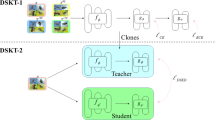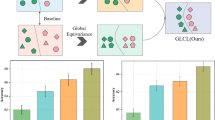Abstract
Cross-domain few-shot learning (CDFSL) addresses learning problems where knowledge needs to be transferred from one or more source domains into an instance-scarce target domain with an explicitly different distribution. Recently published CDFSL methods generally construct a universal model that combines knowledge of multiple source domains into one feature extractor. This enables efficient inference but necessitates re-computation of the extractor whenever a new source domain is added. Some of these methods are also incompatible with heterogeneous source domain extractor architectures. We propose feature extractor stacking (FES), a new CDFSL method for combining information from a collection of extractors, that can utilise heterogeneous pretrained extractors out of the box and does not maintain a universal model that needs to be re-computed when its extractor collection is updated. We present the basic FES algorithm, which is inspired by the classic stacked generalisation approach, and also introduce two variants: convolutional FES (ConFES) and regularised FES (ReFES). Given a target-domain task, these algorithms fine-tune each extractor independently, use cross-validation to extract training data for stacked generalisation from the support set, and learn a simple linear stacking classifier from this data. We evaluate our FES methods on the well-known Meta-Dataset benchmark, targeting image classification with convolutional neural networks, and show that they can achieve state-of-the-art performance.













Similar content being viewed by others
Availability of data and materials
All data used can be acquired publicly via https://github.com/google-research/meta-dataset for the official Meta-Dataset, https://github.com/cambridge-mlg/cnaps for three additional target domains, https://github.com/IBM/cdfsl-benchmark for four additional target domains, and https://data.vision.ee.ethz.ch/cvl/datasets_extra/food-101/ for one additional target domain.
Code availability
The implementation and the computational work are done using the Python programming language and the PyTorch deep learning library (Paszke et al., 2019). The code and data files are available via GitHub at https://github.com/HongyuJerryWang/FeatureExtractorStacking.
Notes
Note that, strictly speaking, this also creates distinct domains because the joint probability distributions will differ. However, they will be strongly related.
References
Bateni, P., Barber, J., van de Meent, J., Wood, F. (2022). Enhancing fewshot image classification with unlabelled examples. IEEE/CVF Winter Conference on Applications of Computer Vision, Waikoloa, HI, USA (pp. 1597-1606). IEEE.
Bateni, P., Goyal, R., Masrani, V., Wood, F., Sigal, L. (2020). Improved few-shot visual classification. 2020 IEEE/CVF Conference on Computer Vision and Pattern Recognition, Seattle, WA, USA (pp. 14481-14490). Computer Vision Foundation / IEEE.
Bossard, L., Guillaumin, M., Gool, L.V. (2014). Food-101 - mining discriminative components with random forests. Computer Vision - ECCV 2014 - 13th European Conference, Zurich, Switzerland (Vol. 8694, pp. 446-461). Springer.
Chen, W., Liu, Y., Kira, Z., Wang, Y.F., Huang, J. (2019). A closer look at few-shot classification. 7th International Conference on Learning Representations, New Orleans, LA, USA. OpenReview.net.
Chen, Y., Liu, Z., Xu, H., Darrell, T., Wang, X. (2021). Meta-baseline: Exploring simple meta-learning for few-shot learning. 2021 IEEE/CVF international conference on computer vision, Montreal, QC, Canada (pp. 9042-9051). IEEE.
Demsar, J. (2006). Statistical comparisons of classifiers over multiple data sets. Journal of Machine Learning Research, 7, 1–30.
Deng, J., Dong, W., Socher, R., Li, L., Li, K., Fei-Fei, L. (2009). Imagenet: A large-scale hierarchical image database. IEEE computer society conference on computer vision and pattern recognition, Miami, Florida, USA (pp. 248-255). IEEE Computer Society.
Dvornik, N., Schmid, C., Mairal, J. (2020). Selecting relevant features from a multi-domain representation for few-shot classification. Computer Vision- ECCV 2020 - 16th European Conference, Glasgow, UK (Vol. 12355, pp. 769-786). Springer.
Galeano, P., Joseph, E., & Lillo, R. E. (2015). The Mahalanobis distance for functional data with applications to classification. Technometrics, 57(2), 281–291.
Guo, Y., Codella, N., Karlinsky, L., Codella, J.V., Smith, J.R., Saenko, K.,. . . Feris, R. (2020). A broader study of cross-domain few-shot learning. Computer Vision - ECCV 2020 - 16th European Conference, Glasgow, UK (Vol. 12372, pp. 124-141). Springer.
He, K., Zhang, X., Ren, S., Sun, J. (2016). Deep residual learning for image recognition. 2016 IEEE Conference on Computer Vision and Pattern Recognition, Las Vegas, NV, USA (pp. 770-778). IEEE Computer Society.
Ioffe, S., & Szegedy, C. (2015). Batch normalization: Accelerating deep network training by reducing internal covariate shift. Proceedings of the 32nd international conference on machine learning, Lille, France (Vol. 37, pp. 448-456). JMLR.org.
Li, W., Liu, X., Bilen, H. (2021). Universal representation learning from multiple domains for few-shot classification. 2021 IEEE/CVF international conference on computer vision, Montreal, QC, Canada (pp.9506-9515). IEEE.
Li, W., Liu, X., Bilen, H. (2022). Cross-domain few-shot learning with task-specific adapters. IEEE/CVF conference on computer vision and pattern recognition, New Orleans, LA, USA (pp. 7151-7160). IEEE.
Li, W.-h., Liu, X., Bilen, H. (2022). Universal representation learning and task-specific adaptation for few-shot learning. https://github.com/VICO-UoE/URL. (Accessed: 2022-09-29)
Liu, L., Hamilton, W.L., Long, G., Jiang, J., Larochelle, H. (2021). A universal representation transformer layer for few-shot image classification. 9th international conference on learning representations, Virtual Event, Austria. OpenReview.net.
Liu, Y., Lee, J., Zhu, L., Chen, L., Shi, H., Yang, Y. (2021). A multi-mode modulator for multi-domain few-shot classification. 2021 IEEE/CVF international conference on computer vision, Montreal, QC, Canada (pp. 8433-8442). IEEE.
Mensink, T., Verbeek, J., Perronnin, F., & Csurka, G. (2013). Distance-based image classification: Generalizing to new classes at near-zero cost. IEEE Transactions on Pattern Analysis and Machine Intelligence, 35(11), 2624–2637.
Paszke, A., Gross, S., Massa, F., Lerer, A., Bradbury, J., Chanan, G., Chintala, S. (2019). Pytorch: An imperative style, high-performance deep learning library. Advances in Neural Information Processing Systems 32, Vancouver, BC, Canada (pp. 8024-8035).
Perez, E., Strub, F., de Vries, H., Dumoulin, V., Courville, A.C. (2018). FiLM: Visual reasoning with a general conditioning layer. Proceedings of the Thirty-Second AAAI Conference on Artificial Intelligence, the 30th innovative Applications of Artificial Intelligence, and the 8th AAAI Symposium on Educational Advances in Artificial Intelligence, New Orleans, Louisiana, USA (pp. 3942-3951). AAAI Press.
Requeima, J., Gordon, J., Bronskill, J., Nowozin, S., Turner, R.E. (2019). Fast and flexible multi-task classification using conditional neural adaptive processes. Advances in Neural Information Processing Systems 32, Vancouver, BC, Canada (pp. 7957-7968).
Russakovsky, O., Deng, J., Su, H., Krause, J., Satheesh, S., Ma, S., & Fei-Fei, L. (2015). Imagenet large scale visual recognition challenge. International Journal of Computer Vision, 115(3), 211–252.
Snell, J., Swersky, K., Zemel, R.S. (2017). Prototypical networks for few-shot learning. Advances in Neural Information Processing Systems 30, Long Beach, CA, USA (pp. 4077-4087).
Tan, M., & Le, Q.V. (2021). Efficientnetv2: Smaller models and faster training. Proceedings of the 38th International Conference on Machine Learning, Virtual Event (Vol. 139, pp. 10096-10106). PMLR.
Tibshirani, R., Saunders, M., Rosset, S., Zhu, J., & Knight, K. (2005). Sparsity and smoothness via the fused lasso. Journal of the Royal Statistical Society: Series B (Statistical Methodology), 67(1), 91–108.
Triantafillou, E., Larochelle, H., Zemel, R.S., Dumoulin, V. (2021). Learning a universal template for few-shot dataset generalization. Proceedings of the 38th international conference on machine learning, Virtual Event (Vol. 139, pp. 10424-10433). PMLR.
Triantafillou, E., Zhu, T., Dumoulin, V., Lamblin, P., Evci, U., Xu, K., . . . Larochelle, H. (2020). Meta-dataset: A dataset of datasets for learning to learn from few examples. 8th International conference on learning representations, Addis Ababa, Ethiopia. OpenReview.net.
Vaswani, A., Shazeer, N., Parmar, N., Uszkoreit, J., Jones, L., Gomez, A.N., . . . Polosukhin, I. (2017). Attention is all you need. Advances in Neural Information Processing Systems 30, Long Beach, CA, USA (pp. 5998-6008).
Vinyals, O., Blundell, C., Lillicrap, T., Kavukcuoglu, K., Wierstra, D. (2016). Matching networks for one shot learning. Advances in Neural Information Processing Systems 29, Barcelona, Spain (pp. 3630-3638).
Wolpert, D. H. (1992). Stacked generalization. Neural Networks, 5(2), 241–259.
Zaheer, M., Kottur, S., Ravanbakhsh, S., Póczos, B., Salakhutdinov, R., Smola, A.J. (2017). Deep sets. Advances in Neural Information Processing Systems 30, Long Beach, CA, USA (pp. 3391-3401).
Funding
This research is funded by the Ministry of Business, Innovation and Employment of New Zealand as part of a Smart Ideas project entitled “User-friendly Deep Learning”, please refer to https://www.mbie.govt.nz/science-and-technology/science-and-innovation/funding-information-and-opportunities/investment-funds/endeavour-fund/.
Author information
Authors and Affiliations
Contributions
All authors contributed to the study conception and design. Material preparation and data collection and analysis were performed by Hongyu Wang. The first draft of the manuscript was written by Wang and all authors commented on previous versions of the manuscript. All authors read and approved the final manuscript.
Corresponding author
Ethics declarations
Conflict of interest
On behalf of all authors, the corresponding author states that there is no conflict of interest.
Additional information
Editor: Steven Schockaert.
Publisher's Note
Springer Nature remains neutral with regard to jurisdictional claims in published maps and institutional affiliations.
Rights and permissions
Springer Nature or its licensor (e.g. a society or other partner) holds exclusive rights to this article under a publishing agreement with the author(s) or other rightsholder(s); author self-archiving of the accepted manuscript version of this article is solely governed by the terms of such publishing agreement and applicable law.
About this article
Cite this article
Wang, H., Frank, E., Pfahringer, B. et al. Feature extractor stacking for cross-domain few-shot learning. Mach Learn 113, 121–158 (2024). https://doi.org/10.1007/s10994-023-06483-x
Received:
Revised:
Accepted:
Published:
Issue Date:
DOI: https://doi.org/10.1007/s10994-023-06483-x































